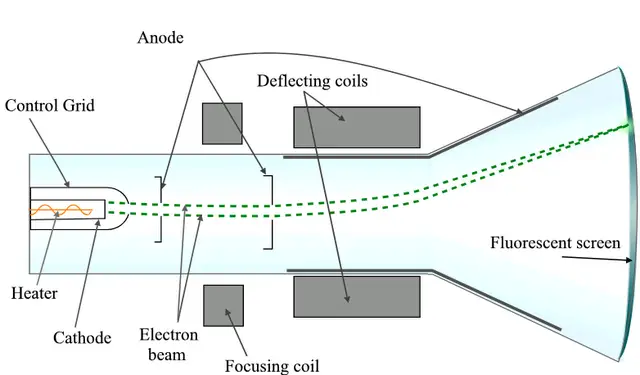What is the full form of CRT?
The CRT full form is Cathode Ray Tube. CRT is a vacuum tube in which an electron beam is bent by magnetic and electric fields created by a fluorescent projector. The objective of cathode ray tubes is to convert an electrical signal into an image. Cathode rays or electron particle beams are fairly straightforward to produce, as electrons orbit each atom and move as electric current from atom to atom.
Read Other Full Forms
The Operation of Cathode Ray Tube
Using an electric field, electrons are accelerated from one end of a cathode ray tube to the other. Once the electrons reach the far end of the tube, their velocity causes them to lose all of their energy, which is then transferred to other forms such as heat. Extremely little heat is transmitted into X-rays.
Interlaced or non-interlaced electron beams in a display move around the screen, and strike phosphorous dots inside the glass tube, which then light up and project onto the display. There are three types of electron-based weapons: green, red, and blue. Due to the magnetic charges that are employed to indicate the direction of electrons, interference occurs when a speaker or other magnetic devices are put near a CRT display. Magnetic charges are not utilized in LCD and flat panels, thus they cannot even resolve interference problems of this nature.

Components of CRT
- Electron Gun – An electron gun produces an electron stream.
- Anodes – Electrons are accelerated by anodes.
- Vertical and Horizontal Deflection Panels — These panels generate the low-frequency electromagnetic field required to change electron beam control.
- Fluorescent display – Phosphor is used to create the fluorescent screen. When struck by light, it emits light.
- Evacuated Glass Envelope – A Cathode ray tube is assembled or transported within an evacuated glass envelope.
Background of CRT
Julius Plücker and Johann Wilhelm Hittorf discovered cathode rays. The first CRT was invented by Ferdinand Braun.
In 1934, Telefunken introduced the first CRT televisions to the German market.
Features of CRT
- CRT displays are huge and heavy.
- CRT has a higher contrast ratio, which makes it easier to discern crisp information in dim images. CRT lacks the ability to produce brilliant white intensities in contrast to liquid crystal displays (LCD).
- CRT is completely discounted and no longer in business. It will soon be impossible to locate CRT on the market, as all manufacturers will have ceased production.
- The ratio of 4:3 is utilized in the CRT of the control panel. Traditional televisions have a black bar at the top and bottom of the screen, indicating that they do not utilize the entire display area. Unlike CRTs, LCDs have a huge width, indicating that they either feature tiny bars or do not.
Applications of CRT
- Used as one of the most prevalent television displays.
- X-rays are produced when the rapid cathode rays are abruptly interrupted.
- In a cathode-ray oscilloscope, CRT is utilized.
- CRTs are less expensive.
- CRTs offer a quick response time and are devoid of moving artifacts.
Limitations of CRT
- CRT display technology is size-dependent.
- CRT displays images with lower pixel density.
- They utilize significantly more electricity.
- They are large, huge, and voluminous.
- Comparatively bright, though not as brilliant as LCD.

